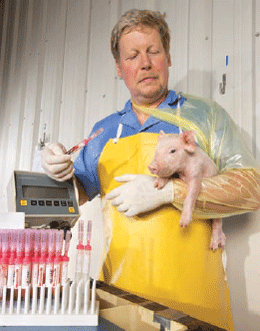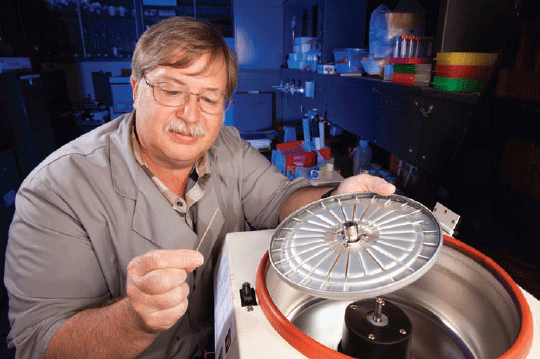



New Tool Predicts Piglet's Nursing Ability
To improve neonatal piglet survival, Agricultural Research Service physiologists have developed a technique to determine whether neonatal piglets have received adequate colostrum from the sow, writes Sanda Avant.Unlike humans, when pigs are
born, they enter the world without
any immunity against foreign
elements like disease-causing pathogens.
Their chance for survival relies heavily
on getting enough colostrum— a milk-like
substance produced by mammals after
giving birth.
Newborns that fail to nurse and receive
colostrum from the sow within the first 24
hours usually die. That is because piglets
are born with limited energy stores, and
colostrum also provides the energy they
need to stay alive.
For the swine industry, pre-weaning
mortality has long been a major problem,
costing an estimated $1.6 billion each year.
Now, a new tool may help give these at-risk
animals a second chance.
To improve neonatal piglet survival,
Agricultural Research Service physiologists
Jeffrey Vallet, Jeremy Miles and Lea
Rempel at the US Meat Animal Research
Center (USMARC) in Clay Center in Nebraska have developed a measuring
technique referred to as the 'immunocrit'
that can determine whether neonatal piglets
have received adequate colostrum
from the sow.
Colostrum contains immunoglobulins,
which are antibodies made by the sows
immune system to protect against bacteria,
viruses and other foreign substances.
Humans receive these antibodies in their
mother's womb but pigs and other livestock
rely on passive transfer through nursing
after birth, says Dr Vallet, research leader
of USMARC's Reproduction Unit. Thus,
piglets are born with no immunoglobulin,
and piglet serum immunoglobulin reflects
their colostrum intake.
"Colostrum gives piglets their first
antibodies so that they can have some
immunological protection during the first
couple of days of life," Dr Miles says. "If
they don’t suckle, they don't have any
immunoglobulins."

Immunocrit at Work
The immunocrit, which measures newborn
piglet serum immunoglobulin, is
simple, inexpensive, rapid and accurate.
It is similar to the haematocrit, used for
years by doctors to measure the volume
of blood cells and determine whether a
patient is anaemic, Dr Vallet says.
Blood samples are taken from piglets on
day one after birth, mixed with ammonia
sulfate to precipitate immunoglobulin, put into a microcapillary tube and spun so the
precipitated immunoglobulin settles to the
bottom. The volume of the precipitated
immunoglobulin is then measured and
divided by the total volume in the tube.
"We can go through a litter of piglets
and take blood samples quickly and easily, and the assay itself is very simple to
use," Dr Vallet says.
Scientists have demonstrated that immunocrit
measurements are predictive of
piglets' mortality and nursing ability and
that the average immunocrit of piglets
in a litter reflects the sow's colostrum
production capability. Because the test
is so rapid, it is possible to identify compromised
piglets and take steps to rescue
them, Dr Vallet says.

Help for the Smallest
The immunocrit is good at identifying
piglets within a litter that have not eaten at
all or have not had the opportunity to nurse,
Dr Miles says.
In one experiment, scientists
used the immunocrit to assess colostrum
intake in a group of piglets — the smallest
from each litter — and then measured the
contents of each piglet's stomach. They
found that some piglets' stomachs were
nearly empty. Those same piglets had an
immunocrit measurement of nearly zero,
validating that the immunocrit accurately
detects piglets that receive no colostrum
within a 24-hour period.
Immunocrit results correlated well with
results from a more complicated and expensive
traditional method — protein A sepharose
combined with electrophoresis — in
detecting piglets that had not nursed at all.
In another study, using more than
2,000 piglets, researchers found that the
immunocrit could predict pre-weaning survival. They also noted a connection
between immunocrit measurements and
piglet weight: heavier piglets were more
likely to survive the challenge of not getting
colostrum within the critical time frame.
Enhancing Management Practices
The immunocrit can be used to test management
practices, such as split suckling,
and other strategies used by swine producers
to help prevent colostrum deficiency, Dr
Vallet says.
Split suckling is a labour-intensive
method that involves marking the first-born
group of piglets, putting them aside, and
then allowing the last piglets born uninhibited
access to the sow. The practice is
designed to improve access to colostrum
for later-born piglets because studies have
shown that there is some influence of birth
order on colostrum intake.
"The immunocrit can be performed 24
hours after the split suckling procedure
to find out if progress is being made in
improving colostrum in different piglets," Dr
Vallet says. "Producers can also use the
immunocrit as a monitoring device for
day-one piglet care. For example, they can
randomly select piglets and benchmark
how those piglets are doing."
The new technique is not just for pigs. It
could also fit well into management practices
of cattle producers. The immunocrit
was successfully used to monitor colostrum
intake of 96 calves 24 hours after birth.
Taking a Genetic Approach
"Another strategy is to use genomics to
modify the colostrum-piglet-mother interaction
during that first 24-hour window," Dr
Vallet says. "We should be able to use the
immunocrit to get some idea of the sow's
ability to produce colostrum and then genetically
select for colostrum production."
Preliminary research conducted by Gary
Rohrer, a geneticist at USMARC, suggests
that individual immunocrit values
are heritable, presumably because nursing
ability is heritable. From analyses of piglets
and their mothers, Dr Rohrer found the most
significant portion of the variation — 50
per cent — is accounted for by the piglet's
genetics. The mother is responsible for 20
percent of the variation.
Immunocrit data collected from 500
litters — about 5,000 piglets — provide a
valid sample for genomic research, Dr Vallet
says. Data from each individual piglet is an
indicator of its nursing ability but the average
across all piglets gives some indication
of the sow's colostrum-production ability.
"When it comes to genetic associations,
the more numbers, the better," Dr Rohrer
says. "Not only do we have a much higher
heritability for the actual piglet's ability or
potential, we also have a lot more records."
Dr Rohrer plans to group DNA from piglets
with very high immunocrit values
and compare it with DNA collected from
piglets with very low values.
"We can efficiently genotype those pools
of DNA, estimate frequencies, and hopefully
identify regions of the genome that
are affecting the pig's ability to acquire
and absorb colostrum," he says.
If successful, researchers would be able
to recommend genetic markers that allow
pork producers to identify and breed sows
that ably produce colostrum and piglets
with improved neonatal nursing abilities —
an outcome that would help reduce
the odds of pre-weaning mortality.
October 2012








